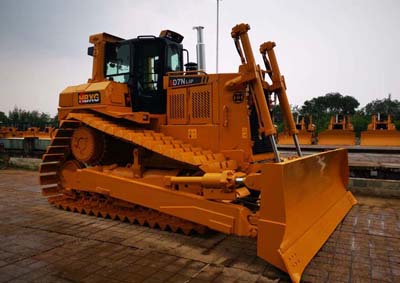Bulldozers are heavy construction machines designed for performing various earth-moving tasks. They are commonly used in construction, mining, and agriculture industries. Different types of bulldozers are available, each with specific features and uses. In this article, we will explore the different types of bulldozers, their parts, and their uses.
Crawler Bulldozers: Crawler bulldozers are the most common type of bulldozer. They have a tracked system, with a set of tracks on either side that allow for greater maneuverability on rough terrains. The tracks evenly distribute the weight of the machine, providing excellent traction and preventing sinking in soft soil. Crawler bulldozers are commonly used in construction sites, road building, and land clearing operations.
Wheel Bulldozers: Unlike crawler bulldozers, wheel bulldozers use large tires instead of tracks. They are ideal for working on softer grounds, such as mud or sand. Wheel bulldozers offer higher traveling speed, making them suitable for projects that require more mobility. They are commonly used in urban construction sites and road maintenance.
Mini Bulldozers: Mini bulldozers, also known as compact bulldozers, are smaller and more maneuverable versions of standard bulldozers. They are commonly used in residential construction, landscaping, and agriculture. Mini bulldozers are effective in working on small-scale projects or in tight spaces where larger bulldozers have limited access.
Now that we have explored different types of bulldozers, let's discuss the key parts of a bulldozer and their uses:
Blade: The blade is the most important part of a bulldozer. It is attached to the front of the machine and is used for pushing, lifting, and moving materials. The blade can be straight or angled, allowing for different types of materials to be moved. Bulldozers with blades are commonly used for grading, leveling, and pushing large quantities of soil, gravel, or debris.
Suggested reading:
Ripper: The ripper is a heavy, claw-like attachment located at the back of a bulldozer. It is used for breaking up compacted soil or rock surfaces. The ripper teeth penetrate the ground, creating trenches or loosening the soil, making it easier for other construction equipment to work on the area. The ripper is commonly used in mining, road construction, and land excavation projects.

Tracks/Tires: The tracks or tires provide mobility to the bulldozer. In crawler bulldozers, tracks are made of rubber or steel, allowing for better traction and stability on uneven terrain. In wheel bulldozers, tires provide mobility and are especially useful on softer grounds. Proper maintenance of tracks or tires is crucial for optimal performance and longevity of the bulldozer.
Cab: The cab is the operator's compartment, providing a safe and comfortable working environment. It is usually located in the center of the bulldozer, offering a clear view of the blade and surrounding area. The cab is equipped with controls for operating the machine, as well as various safety features like air conditioning, sound insulation, and ergonomic seating.
Engine: The engine powers the bulldozer and provides the necessary energy to operate the different components. Bulldozers are equipped with powerful and durable engines designed to handle heavy-duty tasks. Regular maintenance and fuel efficiency are important factors in maximizing the performance and lifespan of the engine.
Hydraulic System: The hydraulic system is responsible for operating the different attachments and components of the bulldozer. It uses hydraulic fluid to transfer power, allowing for precise control of the blade, ripper, and other movements. The hydraulic system enables the operator to adjust the blade height, angle, and tilt, enhancing the bulldozer's versatility.
In conclusion, bulldozers come in various types, each designed for specific applications. Crawler bulldozers are ideal for rough terrains, while wheel bulldozers are suitable for softer grounds. Mini bulldozers offer increased maneuverability in tight spaces. The key parts of a bulldozer include the blade, ripper, tracks/tires, cab, engine, and hydraulic system. Understanding these parts and their uses is essential for operating and maintaining bulldozers efficiently and safely.
Suggested reading:Previous
Related Articles
Comments
Please Join Us to post.
0